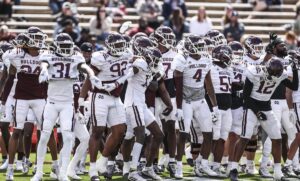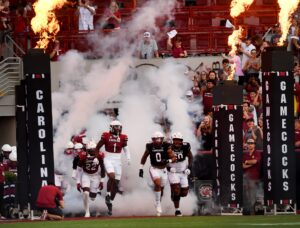Ohio State has had problems on defense for the last two years now, but things came to a head in Week 2.
The Buckeyes were unable to stop the Oregon Ducks, and Ryan Day lost his first regular season game as a head coach.
Things have been bad for Ohio State for a while, but the offense was so good that nobody noticed. For example, Trevor Lawrence passed for 400 yards in the Sugar Bowl, which went under the radar thanks to the 49-spot Justin Fields put up.
Then, the Buckeyes faced the Crimson Tide in the National Championship Game, as Nick Saban and Steve Sarkisian thoroughly picked apart the Ohio State defense. But they had the Heisman Trophy winner and a number of other first-round draft picks, so no defense in college football could stand up to that, right?
But when Ohio State failed to stop Oregon running the same play over and over again, the defense could no longer be ignored.
Day stripped Kerry Coombs of play calling duties and let secondary coach Matt Barnes handle the play sheet. The coaching staff reworked some personnel groupings. Even some of the schemes changed.
Heading into the bye week, Ohio State now has the 33rd scoring defense in the country. Four games after the loss to Oregon, and Ohio State has time to implement the changes it needed. How is it going so far?
How is the Ohio State Defense Doing?
Of course, the tough thing about this is judging the Buckeyes against the level of competition.
Changes didn’t really start happening until after the Week 3 game against Tulsa. Since then, Ohio State has played against Akron, Rutgers, and Maryland. Akron isn’t even a contender in the MAC, Rutgers is still looking for a conference win (though all three of their Big Ten games have been against ranked opponents), and Maryland was depleted against the Buckeyes.
So it’s difficult to measure how far the defense has come for Ohio State. By far, the best teams they have played were Minnesota and Oregon, their Week 1 and Week 2 opponents, respectively.
Against the Gopher and Ducks, Ohio State gave up 472 rushing yards. The two teams found it so effective to run the ball, they did so 88 times. Mohamed Ibrahim led with a whopping 30 attempts before he left the game with an injury. If fully healthy, he would have run even more.
Ibrahim averaged 5.4 yards per carry, which warranted the heavy load. His career average is 5.5 yards per carry, so his production against the Ohio State defense is actually reflective of his usual production.
Oregon running back C.J. Verdell averaged 8.1 yards per carry on 20 carries, quarterback Anthony Brown averaged 6.5 yards on 10 carries, and running back Travis Dye averaged 5.4 yards on eight carries.
The Ohio State game was the best of Verdell’s season. That game inflated his season average to 5.2 yards per carry, despite Verdell never averaging as many as five yards in any other game this season. He also never had as many carries or touchdowns against any other opponent as he did Ohio State. In his whole career, he recorded the fifth-highest single game yardage total and the sixth-most carries of his career.
Rushing is without a doubt the worst part of Ohio State’s game, though the pass rush wasn’t what it should have been.
Through the first two games, the defensive line accounted for one sack and four tackles for a loss. That’s not nearly what a line should produce when they have all of the five star recruits that Ohio State’s has.
Ohio State finished the Tulsa game with two sacks and four tackles for loss against Tulsa. That’s still not great, but it was better than the first two games combined.
Fortunately, rushing wasn’t an issue for Ohio State in the Tulsa game. Unfortunately, the passing game was. The Buckeyes gave up more than 400 passing yards to the Golden Hurricane.
The Tulsa game forced Ohio State to make changes, and changes they made.
In the three games since, the Buckeyes have given up a total of 143 yards on the ground. That’s less than Ibrahim and Verdell each had. Not only that, but opponents rushed 107 times in the last three weeks, leading to a 1.3 average per carry.
Again, it’s difficult to gage how impressive that is. The good news for Buckeye fans is that Ohio State took care of the business they were supposed to. That may not have happened with the Week 1 iteration of the team.
Rutgers running back Isaih Pacheco came of a 20-carry, 107-yard performance against Michigan the week before the Buckeyes came to town. Pacheco averaged over four yards a carry in his previous three games against Ohio State in his career. But in the 2021 matchup, the Buckeyes kept him to eight yards on only six carries.
While Maryland threw some unknowns like Challen Faamatau and Peny Boone at Ohio State, the Buckeyes shut down the Terrapins’ breakout star. Tayon Fleet-Davis had been having a breakout season, and was Maryland’s best running back by far this season. But Ohio State kept him to only seven yards on eight attempts. Entering the Ohio State game, Fleet-Davis averaged seven yards a carry on the season; the Buckeyes dropped his season average by an entire yard.
The Ohio State defense is by no means a finished product. They have yet to be tested by a good team. They’re last three opponents only have one Big Ten between them. And the Buckeyes get Indiana after the bye, which is another team without a conference win.
Ohio State will get tested in November. With Penn State, Michigan State, and Michigan on the horizon, we will see how far this defense has come.
But the signs so far are encouraging. Yes, Ohio State is shutting down weaker opponents, but those opponents had the potential to do damage.
With the changes Ohio State has made on defense, there is no reason to mess with that now.






